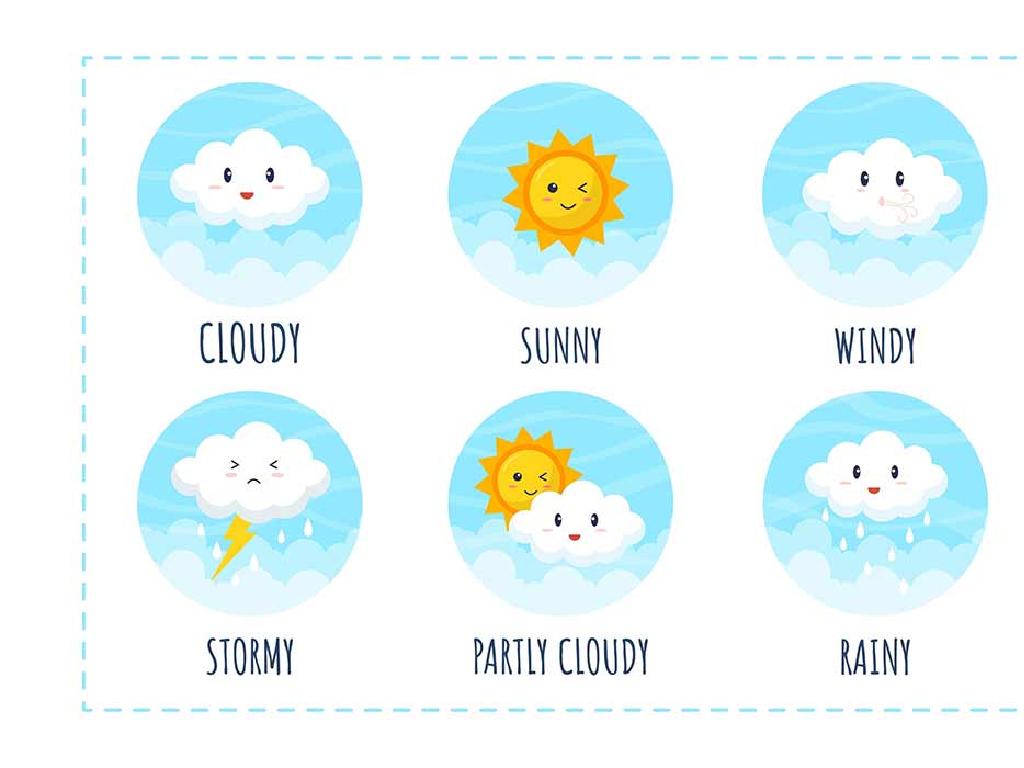Compare Plant And Animal Cells
Subject: Science
Grade: Fourth grade
Topic: Cells
Please LOG IN to download the presentation. Access is available to registered users only.
View More Content
Comparing Plant and Animal Cells
– Explore the cell basics
– Discover what cells are
– Cells are life’s building blocks, found in all living things.
– Compare plant vs animal cells
– Plant cells have cell walls and chloroplasts, animal cells do not.
– Learn cell components
– Both have a nucleus, cytoplasm, and membrane.
|
Begin the lesson by introducing cells as the fundamental units of life, present in all living organisms. Explain that cells come in various shapes and sizes and perform different functions. Highlight the key differences between plant and animal cells, such as the presence of a cell wall and chloroplasts in plant cells, which are absent in animal cells. Discuss the similarities they share, like having a nucleus, cytoplasm, and a cell membrane. Use diagrams to visually represent the components of each cell type. Encourage students to think about why these differences and similarities might exist and how they relate to the functions of each type of cell.
What is a Cell?
– Cells as life’s building blocks
– Think of cells like tiny bricks that make up everything alive.
– Smallest unit of life
– All living things have cells
– Plants, animals, and humans – all are cell-based.
– Cells form our body’s parts
– Our organs and tissues are all made of cells.
|
This slide introduces the concept of cells to fourth-grade students. Begin with the definition of a cell, emphasizing that it is the smallest unit that can be considered alive. Explain that just like buildings are made from bricks, every living organism is made from cells. Highlight that cells are the common thread between all forms of life, including plants, animals, and humans. Discuss how cells come together to form the different parts of our body, like organs and tissues. Use simple analogies and encourage students to think of cells as the building blocks of life. This foundational knowledge sets the stage for comparing plant and animal cells in subsequent slides.
Exploring Cell Types: Plant vs. Animal
– Two main cell types: Plant and Animal
– Common parts in both cells
– Both have a nucleus, cytoplasm, and cell membrane
– Unique structures in plant cells
– Plant cells have a cell wall, chloroplasts for photosynthesis, and a large central vacuole
– Unique structures in animal cells
– Animal cells have lysosomes and centrioles, and come in various shapes
|
This slide introduces students to the basic concept that there are two main types of cells: plant and animal cells. It highlights that while they share some common structures, such as the nucleus which holds the DNA, the cytoplasm where chemical reactions occur, and the cell membrane which controls what enters and leaves the cell, they also have their own unique parts. Plant cells have a rigid cell wall for structure, chloroplasts for making food through photosynthesis, and a large central vacuole for storing water and nutrients. Animal cells, on the other hand, have lysosomes for digestion of nutrients and centrioles which play a role in cell division. They also vary in shape to fit their function. This foundational knowledge sets the stage for understanding the diversity of cell structure and function.
Common Structures in Plant & Animal Cells
– Cell Membrane: Protective layer
– Both plant and animal cells have a cell membrane that acts like a security guard.
– Cytoplasm: Gel-like fluid inside
– Cytoplasm is where all the cell activities happen, like a busy playground.
– Nucleus: Cell’s control center
– The nucleus is like the principal’s office, directing all cell activities.
|
This slide introduces students to the common structures found in both plant and animal cells, emphasizing the cell membrane, cytoplasm, and nucleus. Explain that the cell membrane functions as a protective barrier, controlling what enters and exits the cell. The cytoplasm is described as a gel-like substance where various cell activities occur, and the nucleus is highlighted as the control center, containing DNA and regulating cell growth and reproduction. Use relatable analogies to help students understand the functions of these cell parts. Encourage students to think of the cell as a mini-city, with different parts performing specific roles to keep the city running smoothly.
Plant Cell Specialties
– Cell Wall: Support and shape
– A rigid layer that gives the plant cell its box-like shape.
– Chloroplasts: Photosynthesis site
– Contains green pigment chlorophyll, captures sunlight to make food.
– Large Central Vacuole: Storage
– A big storage sac that holds water, food, and waste.
– Unique to plant cells
|
This slide focuses on the unique features of plant cells that differentiate them from animal cells. The cell wall is a strong, protective structure that maintains the shape of the plant cell. Chloroplasts are the site of photosynthesis, the process by which plants convert sunlight into energy, and they contain the green pigment chlorophyll. The large central vacuole acts as a storage center for water, nutrients, and waste products. These components are not found in animal cells, making them distinctive features of plant cells. Encourage students to think about why these features are important for plants and how they help plants survive and grow.
Animal Cell Specialties
– Animal cells lack a cell wall
– This makes them flexible and able to change shape.
– They have small vacuoles
– These store less nutrients compared to plant cells.
– Lysosomes are present
– These organelles help digest waste inside the cell.
– Flexibility and waste breakdown
|
This slide focuses on the unique features of animal cells. Unlike plant cells, animal cells do not have a rigid cell wall, which allows them to be more flexible and change shape. This is important for the variety of functions animal cells perform. Small vacuoles in animal cells are responsible for storing nutrients, but they are much smaller than those found in plant cells. Lysosomes are specialized organelles that break down waste materials and cellular debris. Understanding these differences helps students appreciate the diversity of cell structures and their specific roles in the life of an organism. Encourage students to think about why flexibility might be important for animal cells and how these special features help the cell function effectively.
Comparing Plant and Animal Cells
– Both have cell membranes
– Plants have cell walls, animals don’t
– The cell wall provides extra support and shape
– Plants have chloroplasts for photosynthesis
– Chloroplasts allow plants to make their own food
– Cell differences relate to their functions
– These unique features help them survive in their environments
|
This slide aims to highlight the similarities and differences between plant and animal cells, which are both eukaryotic cells. Students should understand that while both cell types share several structures, such as a cell membrane, cytoplasm, and genetic material, they also have distinct differences that are crucial for their survival. The cell wall in plant cells provides rigidity and protection, while chloroplasts enable plants to perform photosynthesis, a process that converts light energy into chemical energy. These differences are adaptations to their respective environments and lifestyles, with plants being autotrophic (making their own food) and animals being heterotrophic (relying on consuming food). Encourage students to think about how these cellular differences affect the overall organism and its way of life.
Microscopic Marvels: Observing Cells
– Scientists use microscopes
– Microscopes reveal cell details
– Microscopes magnify cells so we can see structures like the nucleus and cell membrane.
– Comparing plant & animal cells
– Plant cells have a rigid wall, and chloroplasts; animal cells do not.
– Real-life cell images
– We’ll look at actual images to see the differences clearly.
|
This slide introduces students to the tools scientists use to study cells, emphasizing the importance of microscopes in cell observation. Highlight how microscopes can magnify tiny cells to a size where we can see their complex structures. Explain the key differences between plant and animal cells, such as the presence of a cell wall and chloroplasts in plant cells. Show real-life images of both plant and animal cells to give students a visual understanding of these differences. Encourage students to ask questions about what they observe in the images and relate the cell structures to their functions.
Class Activity: Cell Model Creation
– Craft your own cell model
– Label each cell part
– Use labels like ‘nucleus’, ‘mitochondria’
– Explain parts to the class
– Share what each part does
– Discuss plant vs. animal cells
– Highlight differences like cell wall in plant cells
|
This activity is designed to help students learn about the structure and function of plant and animal cells by creating a hands-on model. Provide a variety of craft materials such as clay, beads, yarn, and construction paper. Students can choose to create either a plant or an animal cell and must label parts such as the nucleus, cytoplasm, and mitochondria. Encourage creativity in their models. After crafting, each student will present their model to the class, explaining the function of each labeled part. Discuss the differences between plant and animal cells, such as the presence of a cell wall and chloroplasts in plant cells. Possible variations of the activity could include group work to create larger models, using different materials for each type of cell, or even creating a digital model using computer software.
Conclusion: Plant vs. Animal Cells
– Recap of cell similarities
– Both have nucleus, cytoplasm, and membrane
– Cells as life’s building blocks
– Cells form tissues, organs, and systems
– Importance of plant and animal cells
– Plant cells make food, animal cells move
– What’s next: Cell Functions
|
As we wrap up today’s lesson, let’s review the key similarities and differences between plant and animal cells. Remember, both types of cells have a nucleus, cytoplasm, and a cell membrane. Cells are the fundamental building blocks of all living organisms, forming tissues, organs, and entire systems. Plant cells are unique with their ability to produce food through photosynthesis, while animal cells are specialized for movement. Looking ahead, we’ll explore how these cells function within living organisms in our next lesson. Encourage students to think about how the different parts of cells contribute to their overall function.






